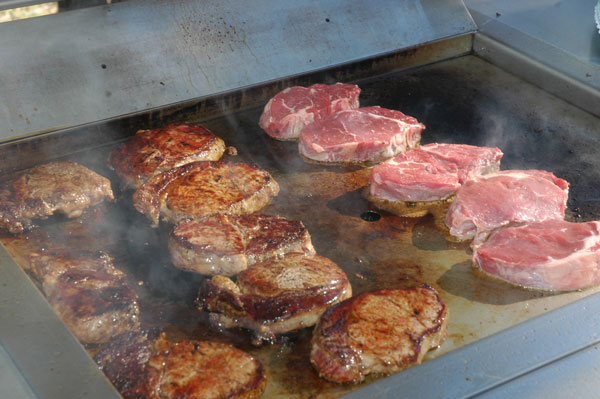December 4, 2014

Cattlemen are an optimistic bunch. In the middle of a drought, we’re always looking at the next rain cloud to bring it to an end. In the midst of a terrible market, we’re placing feeders and preparing for the next round, which we’re sure will be better.
The ironic thing about cattlemen is that we tend to become pessimists when things are good. Nothing makes a cowboy more nervous than prosperity.
I was gathering cows a while back with a cowboy who was riding a horse that had a history of being a total bronc. Yet, the day went along without a single bobble; the horse was perfectly behaved. As we were loading the last cow, I remarked to my friend that I was a little disappointed as I’d been looking forward to watching a rodeo. “I’ll bet you had a pretty enjoyable day,” I told him.
He laughed and said he was exhausted, as he’d spent the whole day waiting for the horse to come unglued. In fact, he told me it was one of the most draining days he’d ever spent on horseback. I just had to laugh; cowboys just can’t seem to enjoy the good times, and are always looking for the next wreck.
I relate that story because, while everyone’s been pleasantly surprised with beef demand in the face of ever-tightening supplies, the common worry is over what it will take to make demand plummet. Without question, consumers have shown they’re willing to pay higher prices. After all, retail beef prices are up 20% compared to a year ago. The logic goes that something will happen to beef demand, because it can’t be sustained.
Of course, I do understand the logic that tighter beef supplies will be offset, or partially offset, by growing supplies of pork and poultry, which will put a strain on beef demand. And I certainly agree with the logic that consumers expect more when they pay more.
The quality vs. quantity debate is valid, especially in times of tight supply and higher prices. The importance of quality relative to demand is likely increasing, and that’s something the industry has to bear in mind. Fortunately, tight numbers have led to increased carcass weights and incentives to feed cattle longer, which should be positively correlated to quality.
The downside of the trend to longer feeding is that portion sizes are increasing. The red flag has gone out that these increased cut sizes will result in lowered demand, especially for the middle meats. It is here that I become a little bit more of a skeptic.
During the first National Beef Quality Audit, portion size was a primary concern of retailers, wholesalers and HRI people. The trend at the time was for smaller portion sizes, and the argument was that fabricators didn’t want to cut the various cuts thinner than 1-in. thick, consumers wouldn’t accept portioning of these cuts and that larger cuts created too many problems.
However, when the differences were calculated for how much more one would have to pay for a 10-in. ribeye for example, over a 16-in. ribeye, the conversation ended and the market soon adapted. In fact, the oposite happened -- despite steaks being cut in half, there was no apparent backlash from consumers.
Admittedly, we’re talking about much larger carcass weights than we were then, and people point out that the demand for larger cuts isn’t growing. The economics and efficiencies of production, though, are overwhelming. Packers are redesigning coolers and equipment to deal with heavier carcass weights and I believe the system will continue to innovate and deal with larger cuts of meats.
I’m not saying that it doesn’t pay to continue to monitor consumer demand and that portion or cut sizes are not an issue. However, my guess is that the overall economics will continue to favor larger carcass weights and the market’s ability to adapt and use these carcasses in an innovative fashion will be more of a key to growing demand than the approach of reducing carcass weights.
Thanksgiving example
I don’t want to sound overly simplistic, but I’ll cite a personal example here. At Thanksgiving in my home this year, we were feeding a large number of people some pretty good beef. My great-grandma only wanted a small portion, as did the eighth-grade girls, while the high school boys and grandpa wanted as much as they could get, and seconds to boot. They all raved about the quality and taste. I was in charge of portion control and the solution was pretty simple; I merely cut the meat to the right size.
I know it’s not that simple in the wider world where there are waste issues, and uniformity and consistency are paramount. However, I have a lot of faith in the innovation of those who handle our product beyond the packer door. Their incentive to deal with these larger cuts is the same as they are for the feeder and packer. Dollars and profits have a way of encouraging adaptation.
The opinions of Troy Marshall are not necessarily those of beefmagazine.com and the Penton Agriculture Group.
You might also like:
Share This --> Breathtaking Photos Of Winter On The Ranch
Reader Gallery: Home Is Where You Hang Your Hat
3 Steps To Negotiating A Great Cow Lease
Grass-Fed Vs Grain-Fed Ground Beef | Experts Prove No Difference In Healthfulness
How To Minimize Cold Stress On Cattle This Winter
Gallery: Ranching Is A Family Affair; Meet The Generations On The Ranch
How To Treat Lump Jaw Disease In Cattle
About the Author(s)
You May Also Like



